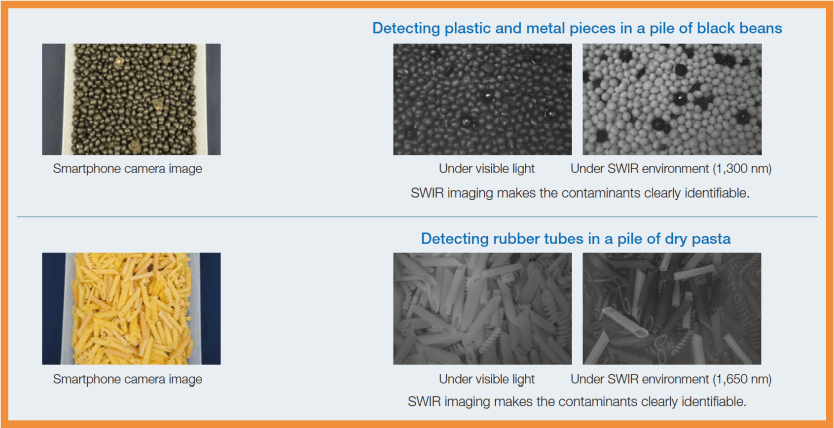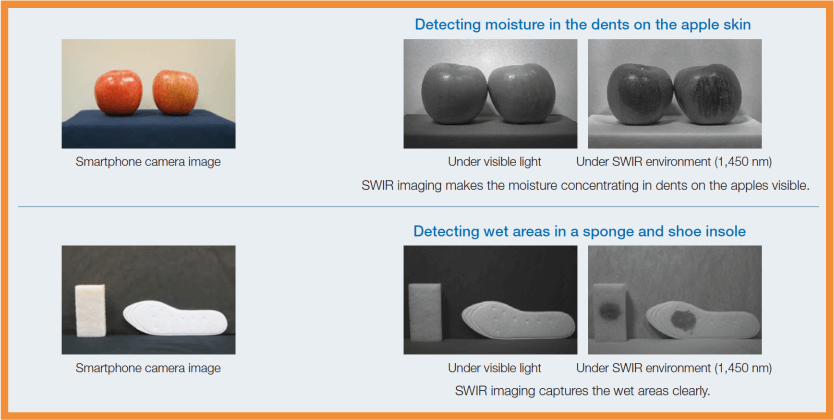SWIR cameras
 SWIR cameras
SWIR cameras were introduced to the field of machine vision to augment the existing imaging technology and enhance precision and accuracy. They have the capability to reveal and detect objects that are otherwise inaccessible to the visible spectrum. Our SWIR cameras are Visible-SWIR, meaning that they can detect not only the SWIR range but also the visible field, eliminating the need of two separated cameras.
The SWIR cameras can be used for a variety of applications such as moisture detection, semiconductors inspection or distinguishing different materials types. Besides the typical visible SWIR cameras, we offer SWIR cameras with the TEC cooling technology with the option of a fan. Using one of our Visible-SWIR lenses is highly recommend to pair with your Visible-SWIR camera. Our SWIR lenses in different focal lengths can be found here:
SWIR lenses.
What is SWIR?
The visible spectrum of wavelengths ranges from 400nm to 780nm. The spectrum of wavelengths from 780nm to 1000µm is known as infrared light. SWIR light is also known as Short-Wave Infrared light, this refers to the infrared wavelength spectrum close to the visible light which ranges from approximately 900nm to 2500nm. Unlike visible light and thermal infrared light, SWIR occupies a unique middle ground. Sensors used in SWIR imaging usually cover the range from 900nm to 1700nm. This spectral range is characterized by its ability to penetrate certain materials and atmospheric conditions. SWIR imaging offers distinct advantages in imaging applications for high-resolution images, such as silicon wafer inspection.
Using SWIR cameras in machine vision?
The SWIR cameras offer a great solution in machine vision, this is because it has the capability to capture information which is not visible for the human eye. It can reveal details in low-light conditions and provides visibility through certain materials that may be opaque in the visible spectrum. Compared to other machine vision cameras, Visible-SWIR cameras offer a cost-effective imaging solution. Visible-SWIR cameras replace the need for multiple cameras operating in different spectrums. This unification results in cost savings and simplified maintenance.
Another benefit of SWIR cameras is the improved imaging in challenging environments. SWIR cameras are generally less affected by common environmental factors such as fog, smoke and haze, making it highly valuable in outdoor and challenging indoor settings. This resilience to environmental conditions ensures a reliable performance in diverse machine vision applications. In addition, SWIR cameras can detect temperature variations by converting heat into luminosity information. We offer SWIR cameras that are suitable for the observation of heat over 250ᵒC. Substances at this temperature or higher emits lights in the SWIR band. This characteristic is useful in industries such as the steel industry.
One last benefit of SWIR cameras is that they offer a good solution for analysis of different types of material. SWIR cameras can differentiate between materials based on their composition. Infrared reflectance and absorptance varies at different wavelengths from one material to another, the ability to differentiate between materials is useful in many industries. This is especially true for tasks such as quality control, where the analysis of the composition of some materials is critical. Particularly for applications with similar materials to be distinguished, SWIR cameras have the capability to single these out. The image below shows an example of detecting plastic and metal pieces in a pile of black beans and detecting rubber tubes in a pile of dry pasta.

Machine vision applications with SWIR Cameras
SWIR cameras can be used in a variety of machine vision applications:
- Industrial Inspection: SWIR cameras are employed in the industry for inspection and defect detection, ensuring quality of the final product. Light in this wavelength has the property to penetrate materials such as silicon and glass, both common used materials in the glass industry. It is also commonly used in the food industry for sorting fruits and vegetables and moisture detection. In images taken with a SWIR camera at the wavelength of 1450nm, the water absorbs the light and becomes black. This property makes it easy to identify moisture content in the sorting process.
- Medical Imaging: In medical applications, SWIR cameras aid in diagnostics, imaging through biological tissues and studying molecular composition.
- Agricultural Monitoring: Unlike color cameras, SWIR cameras assist in monitoring crop health, assessing soil composition and detecting moisture content. An example is given in the image below, where moisture in the dents of an apple skin are detected. With this information, a more accurate analysis can be made. This is vital for precision agriculture and optimizing agricultural techniques.

The SWIR technology is still evolving, and the use of SWIR cameras in the field of machine vision is expected to expand. The combination of SWIR cameras with artificial intelligence and machine learning algorithms can improve the applications in machine vision, enabling more precise process automation.
Benefits of a Visible-SWIR camera
Unlike the traditional SWIR camera, the visible-SWIR camera has the ability to capture images both visible and short-wave infrared range. This dual capability provides a more comprehensive view and combines the benefits of a single device with visible and SWIR imaging.
One of the advantages of visible-SWIR camera is its ability to incorporate the visible spectrum to the image. This way, the user can have a better understanding and can interpret the image. The visible range is more familiar and easy to discern. By having both images, the recognition and analysis can be done instead of relying purely on the SWIR information. This can be seen in both images shown below, where SWIR imaging makes discerning cooking oil from water and the different container contents possible.


A practical benefit of visible-SWIR camera is its ability to operate in different lighting conditions. Whether it is bright daylight or low-light during nighttime, the camera is able to adapt to the different light conditions and provide a sharp image. This capacity is very useful in a wide range of fields such as imaging scientific research and industrial inspections. It is a very flexible device and can replace the traditional visible light camera + SWIR camera dual detection scheme. The use of
SWIR cameras reduces costs, expands the detection range and improves the processing speed.





